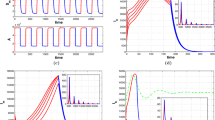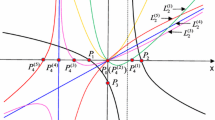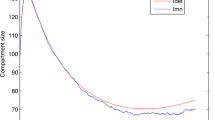Abstract
Controlling the mosquito population is a big challenge for humans. In this paper, we have studied the effects of impulsive control strategies on the spread of mosquito-borne diseases considering the latent period. Therefore, we proposed and analyzed a mosquito-borne disease model governed by a system of impulsive delay differential equations. The proposed mosquito-borne disease model also accounts for three different impulsive control strategies, namely vaccination, pesticides, and adulticides. Two thresholds \(R_1\) and \(R_2\) established for the global attractivity of the disease-free state and the persistence of the endemic state. The non-trivial disease-free solution of the proposed model is globally asymptotically stable if \(R_1\) and \(R_2\) less than one. It is shown that a unique positive endemic periodic solution exists only when \( R_1 \) and \( R_2\) greater than unity, which makes for the persistence of the disease. Numerical simulation supports the analytical finding and shows the effectiveness of the impulse control strategies.








Similar content being viewed by others
References
Bacaer, N., Dads, E.H.A.: Genealogy with seasonality, the basic reproduction number, and the influenza pandemic. J. Math. Biol. 62, 741–762 (2011)
Bacaer, N., Guernaoui, S.: The epidemic threshold of vector-borne diseases with seasonality. J. Math. Biol. 53, 421–436 (2006)
Becker, N., Petrick, D., Boase, C., Lane, J., Zgomba, M., Dahl, C., Kaiser, A.: Mosquitoes and Their Control, 2nd edn. Springer, New York (2010)
Chavez, J.P., Gotz, T., Siegmund, S., Wijaya, K.P.: An SIR-Dengue transmission model with seasonal effects and impulsive control. Math. Biosci. 289, 29–39 (2017)
Cheng, Y., Pan, Q., He, M.: Disease control of delay SEIR model with nonlinear incidence rate and vertical transmission. Comput. Math. Methods Med. 830237 (2013). https://doi.org/10.1155/2013/830237
Cheng, Y., Pan, Q., He, M.: Stability analysis of hepatitis B virus model with incomplete immunization of hepB vaccine. Abstr. Appl. Anal. 427639 (2014). https://doi.org/10.1155/2014/427639
Dias, C., Moraes, D.: Essential oils and their compounds as aedes aegypti l. (diptera: Culicidae) larvicides: review. Parasitol. Res. 113(2), 565–592 (2014)
d’Onofrio, A.: Stability properties of pulse vaccination strategy in SEIR epidemic model. Math. Biosci. 179, 57–72 (2002)
Dumont, Y., Tchuenche, J.: Mathematical studies on the sterile insect technique for the chikungunya disease and Aedes albopictus. J. Math. Biol. 65(5), 809–854 (2011)
Fatoorehchi, H., Alidadi, M., Rach, R., Shojaeian, A.: Theoretical and experimental investigation of thermal dynamics of Steinhart-hart negative temperature coefficient thermistors. J. Heat Transf. 141, 072003 (2019)
Gao, S., Chen, L., Teng, Z.: Pulse vaccination of an SEIR epidemic model with time delay. Nonlinear Anal. RealWorld Appl. 9, 599–607 (2008)
Gao, S., Teng, Z., Xie, D.: The effects of pulse vaccination on SEIR model with two time delays. Appl. Math. Comput. 201, 282–292 (2008)
Hou, J., Teng, Z.: Continuous and impulsive vaccination of SEIR epidemic models with saturation incidence rates. Math. Comput. Simul. 79, 3038–3054 (2009)
Kuang, Y.: Delay Differential Equation with Application in Population Dynamics, pp. 67–70. Academic Press, New York (1993)
Lakshmikantham, V., Bainov, D., Simeonov, P.: Theory of Impulsive Differential Equations. World Scientific, Singapore (1989)
Lana, R.M., Carneiroa, T.G., Honoriob, N.A., Codeco, C.: Seasonal and nonseasonal dynamics of aedes aegypti in rio de janeiro, Brazil: fitting mathematical models to trap data. Acta Tropica 129, 25–32 (2014)
Li, W., Pang, Y.: Application of Adomian decomposition method to nonlinear systems. Adv. Differ. Equ. 67, 2020 (2020)
Lopez-Gatell, H., Alpuche-Aranda, C.M., Santos-Preciado, J.I., Hernandez-Avila, M.: Dengue vaccine: local decisions, global consequences. World Health Organ. 94, 850–855 (2016)
Lou, J., Lou, Y., Wu, J.: Threshold virus dynamics with impulsive antiretroviral drug effects. J. Math. Biol. 65, 623–652 (2012)
Ma, C.: A novel computational technique for impulsive fractional differential equations. Symmetry 11, 216 (2019)
Meng, X., Chen, L.: The dynamics of a new SIR epidemic model concerning pulse vaccination strategy. Appl. Math. Comput. 197, 582–597 (2008)
Meng, X., Chen, L., Cheng, H.: Two profitless delays for the SEIRS epidemics disease model with nonlinear incidence and pulse vaccination. Appl. Math. Comput. 186, 516–529 (2007)
Pates, H., Curtis, C.: Mosquito behavior and vector control. Annu. Rev. Entomol. 50, 53–70 (2004)
Sisodiya, O.S., Misra, O., Dhar, J.: Dynamics of cholera epidemics with impulsive vaccination and disinfection. Math. Biosci. 298, 46–57 (2018)
Thome, R., Yang, H., Esteva, L.: Optimal control of Aedes aegypti mosquitoes by the sterile insect technique and insecticide. Math. Biosci. 223, 12–23 (2010)
Wang, X., Tao, Y., Song, X.: Pulse vaccination on SEIR epidemic model with nonlinear incidence rate. Appl. Math. Comput. 210, 398–404 (2009)
Wei, C., Chen, L.: A delayed epidemic model with pulse vaccination. Discrete Dyn. Nat. Soc. 746951 (2008). https://doi.org/10.1155/2008/746951
WHO.: Temephos in Drinking Water: Use for Vector Control in Drinking water Sources and Containers. https://www.who.int/water_sanitation_health/dwq/chemicals/temephos.pdf
Xiao, Y., Chen, L.: Modelling and analysis of a predator-prey model with disease in the prey. Math. Biosci. 171, 59–82 (2001)
Xin-zhu, M., Lan-sun, C., Zhi-tao, S.: Global dynamics behaviors for new delay SEIR epidemic disease model with vertical transmission and pulse vaccination. Appl. Math. Mech. 28(9), 1259–1271 (2007)
Yang, C.X., Nie, L.F.: Modelling the use of impulsive vaccination to control rift valley fever virus transmission. Adv. Differ. Equ. 134, 1–18 (2016)
Zhang, T., Meng, X., Zhang, T.: SVEIRS: a new epidemic disease model with time delays and impulsive effects. Abstr. Appl. Anal. 542154 (2014). https://doi.org/10.1155/2014/542154
Zhang, T., Teng, Z.: Pulse vaccination delayed SEIRS epidemic model with saturation incidence. Appl. Math. Model. 32, 1403–1416 (2008)
Zhao, Z., Chen, L., Xinyu, S.: Impulsive vaccination of SEIR epidemic model with time delay and nonlinear incidence rate. Math. Comput. Simul. 79, 500–510 (2008)
Acknowledgements
We are very grateful to the reviewers for their valuable suggestions and careful reading of the manuscript.
Author information
Authors and Affiliations
Corresponding author
Ethics declarations
Conflict of interest
None.
Additional information
Publisher's Note
Springer Nature remains neutral with regard to jurisdictional claims in published maps and institutional affiliations.
Appendices
Appendix A: Lemmas
Lemma 1
(see [33]) Let consider the following impulsive system:
where \(a,b >0, 0<\theta <1.\) Then there exist a unique positive periodic solution of (46)
Which is globally asymptotically stable, where
Lemma 2
( See [14, 29]) Let us consider the following delay differential equation
where \( a_1, a_2, \tau > 0\); \(p(t) > 0\) for \( -\tau \le t \le 0.\) We have:
-
(1)
if \(a_1 < a_2\), then \(\lim _{t\rightarrow \infty } p(t) = 0;\)
-
(2)
if \(a_1 > a_2\), then \(\lim _{t\rightarrow \infty } p(t) = +\infty .\)
Appendix B: Definitions
Definition 1
System (1) is said to be uniformly persistent if there exist positive constants \( Q_i \ge q_i, \ \ i= 1,2,3,4.\) ( both are independent of the initial values ), such that every solution \((S_h(t),I_h(t),R_h(t),A_m(t),S_m(t), I_m(t))\) with positive initial conditions (2) of system (1) satisfies:
Definition 2
System (1) is said to be permanent if there exists a compact region \(\varOmega _0 \in \varOmega \) such that every solution \((S_h(t),I_h(t),R_h(t),A_m(t),S_m(t), I_m(t))\) with initial condition (2) of system (1) will eventually enter and remain in the region \(\varOmega _0.\)
Appendix C: Proof
First, If \([I_h(t)+I_m(t)] > q^* \) for all \( t> t_1,\) then our aim is fulfilled. Second \( I_h(t)+I_m(t) \) oscillates about \(q^*\) for all large t; setting \(t^* = inf_{t> t_1} (I_h(t)+I_m(t)) \le q^*,\) there are two possible cases for \( t^*.\) We hope to show that \( (I_h(t)+I_m(t))\ge q \) for all large t. The conclusion is evident in the first case. For the second case, let \(t^* >0\) and \(\rho >0\) satisfy \( I_h(t^*)+I_m(t^*) = I_h(t^*+\rho )+I_m(t^*+\rho )= q^*,\) and \( ( I_h(t)+I_m(t)) < q^*,\) \(S_h(t) > \rho _1\) for \( t^*< t < t^*+\rho .\) Therefore, it is certain that there exists a \(\psi (0<\psi <\tau )\) such that
In this case, we will discuss three possible cases in terms of the size of \(\rho , \psi ,\) and \(\tau \).
Case I. If \(\rho \le \psi \le \tau \), then \( (I_h(t)+I_m(t)) > \frac{q^*}{2} \ \ \ \ for \ \ \ \ t^*< t < t^*+\rho .\)
Case II. If \(\psi \le \rho \le \tau \), then from equations of system (1), we can deduce \(I'_h(t)+I'_m(t) >-\varPi ( I_h(t)+I_m(t))\), where \(\varPi = max\{\mu _h + \omega _h+d, \mu _m\}\) for \(t \varepsilon [t^*, t^*+\tau \) and \( (I_h(t^*)+I_m(t^*)) = q^*\); it is obvious that \( I_h(t)+I_m(t) = Q_1\) for \( t^*< t < t^*+\psi .\) Case III. If If \(\psi \le T \le \rho \), we will consider the following two cases, respectively.
Case IIIa. For \(t^*< t < t^*+\tau \), it is easy to obtain \(( I_h(t)+I_m(t)) > Q_1 \).
Case IIIb. For \(t^*+\tau< t < t^*+\rho \), it is easy to obtain \((I_h(t)+I_m(t)) > Q_1.\) Then, proceeding exactly as the proof for the above claim, we see that \( ( I_h(t)+I_m(t)) \ge q \) for \(t^*+\tau< t < t^*+\rho \). Since this kind of interval \([t^*, t^*+\rho ]\) is chosen in an arbitrary way ( we only need \(t^*\) to be large), we conclude that of our above discussions, the choices of q are independent of the positive solution, and we have proved that any positive solution of system (1) satisfies \( (I_h(t)+I_m(t)) \ge q \) for all large t. The proof is completed.
Rights and permissions
About this article
Cite this article
Sisodiya, O.S., Misra, O.P. & Dhar, J. Modeling effects of impulsive control strategies on the spread of mosquito borne disease: role of latent period. J. Appl. Math. Comput. 68, 2589–2615 (2022). https://doi.org/10.1007/s12190-021-01631-9
Received:
Revised:
Accepted:
Published:
Issue Date:
DOI: https://doi.org/10.1007/s12190-021-01631-9




